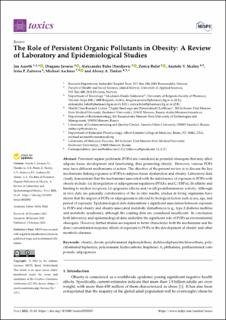| dc.contributor.author | Aaseth, Jan | |
| dc.contributor.author | Javorac, Dragana | |
| dc.contributor.author | Djordjevic, Aleksandra Buha | |
| dc.contributor.author | Bulat, Zorica | |
| dc.contributor.author | Skalny, Anatoly V. | |
| dc.contributor.author | Zaitseva, Irina P. | |
| dc.contributor.author | Aschner, Michael | |
| dc.contributor.author | Tinkov, Alexey A. | |
| dc.date.accessioned | 2023-02-08T13:49:31Z | |
| dc.date.available | 2023-02-08T13:49:31Z | |
| dc.date.created | 2022-05-24T12:59:16Z | |
| dc.date.issued | 2022 | |
| dc.identifier.citation | Toxics. 2022, 10 (2), . | en_US |
| dc.identifier.issn | 2305-6304 | |
| dc.identifier.uri | https://hdl.handle.net/11250/3049382 | |
| dc.description.abstract | Persistent organic pollutants (POPs) are considered as potential obesogens that may affect adipose tissue development and functioning, thus promoting obesity. However, various POPs may have different mechanisms of action. The objective of the present review is to discuss the key mechanisms linking exposure to POPs to adipose tissue dysfunction and obesity. Laboratory data clearly demonstrate that the mechanisms associated with the interference of exposure to POPs with obesity include: (a) dysregulation of adipogenesis regulators (PPARγ and C/EBPα); (b) affinity and binding to nuclear receptors; (c) epigenetic effects; and/or (d) proinflammatory activity. Although in vivo data are generally corroborative of the in vitro results, studies in living organisms have shown that the impact of POPs on adipogenesis is affected by biological factors such as sex, age, and period of exposure. Epidemiological data demonstrate a significant association between exposure to POPs and obesity and obesity-associated metabolic disturbances (e.g., type 2 diabetes mellitus and metabolic syndrome), although the existing data are considered insufficient. In conclusion, both laboratory and epidemiological data underline the significant role of POPs as environmental obesogens. However, further studies are required to better characterize both the mechanisms and the dose/concentration-response effects of exposure to POPs in the development of obesity and other metabolic diseases. | |
| dc.language.iso | eng | en_US |
| dc.relation.uri | https://www.mdpi.com/2305-6304/10/2/65 | |
| dc.rights | Navngivelse 4.0 Internasjonal | * |
| dc.rights.uri | http://creativecommons.org/licenses/by/4.0/deed.no | * |
| dc.title | The Role of Persistent Organic Pollutants in Obesity: A Review of Laboratory and Epidemiological Studies | en_US |
| dc.title.alternative | The Role of Persistent Organic Pollutants in Obesity: A Review of Laboratory and Epidemiological Studies | en_US |
| dc.type | Peer reviewed | en_US |
| dc.type | Journal article | en_US |
| dc.description.version | publishedVersion | |
| dc.source.pagenumber | 30 | en_US |
| dc.source.volume | 10 | en_US |
| dc.source.journal | Toxics | en_US |
| dc.source.issue | 2 | en_US |
| dc.identifier.doi | 10.3390/toxics10020065 | |
| dc.identifier.cristin | 2026956 | |
| cristin.ispublished | true | |
| cristin.fulltext | original | |
| cristin.qualitycode | 1 | |

